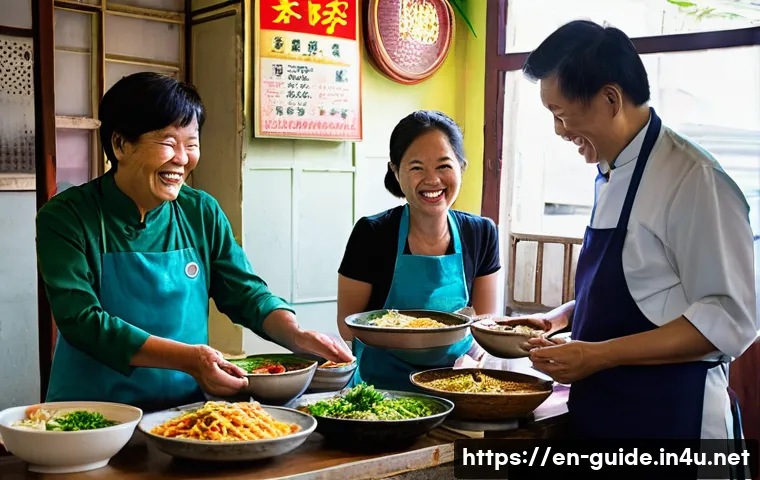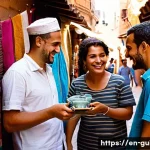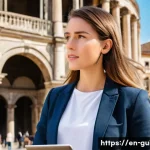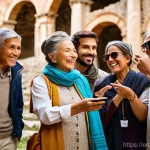Hey everyone! Have you ever experienced that amazing feeling of truly connecting with someone whose world is completely different from your own? As tourist interpreters, we’re in a uniquely privileged position, not just to translate languages but to literally build bridges between cultures, creating unforgettable, authentic experiences for every single one of our guests.

But let’s be real – in our fast-paced, hyper-connected world, simply speaking a few languages just isn’t enough anymore to truly stand out. What really sets exceptional guides apart is a profound global mindset, a way of seeing the world that anticipates nuances, respects traditions, and fosters genuine understanding beyond words.
If you’re serious about taking your guiding career to the next level and making a deeper, more meaningful impact, you’re exactly where you need to be.
Let’s dive right in and unlock the secrets to mastering your global mindset!
Cultivating Deep Cultural Curiosity: It’s More Than Just Facts
You know, after years of guiding folks from every corner of the globe, I’ve really learned that a global mindset starts way before you even open a history book. It’s about a deep, almost insatiable, curiosity for other cultures. It’s not just about memorizing dates or names, though those are important, of course. It’s about genuinely wanting to understand *why* people do what they do, *why* certain traditions hold such significance, and how their worldview shapes their interactions. I remember this one time, leading a group from Japan through a bustling market in Morocco. Instead of just pointing out the crafts, I encouraged them to engage with the artisans, to ask about their techniques and the stories behind their creations. The joy on their faces, the way their eyes lit up when they felt that connection, was just incredible. That’s the magic, isn’t it? It’s about moving beyond surface-level observations and really digging into the soul of a place and its people. This takes practice, an open heart, and a willingness to sometimes feel a little uncomfortable, to step outside your own cultural comfort zone. But trust me, those are the moments where true growth happens, both for you and for your guests. You’re not just a guide; you’re a bridge-builder, and that journey starts with a sincere desire to learn and connect. Cultivating this type of genuine interest isn’t something you can fake; it comes from within, but it’s a muscle you can absolutely strengthen over time.
Embracing Continuous Learning and Exploration
My friends, I cannot stress this enough: the world is constantly changing, and so should our knowledge base! I make it a point to regularly dive into documentaries, read international news, and even try new cuisines. It keeps my perspective fresh and gives me relatable points of reference for my guests. For instance, if I know a group is from a particular region, I might spend an evening watching a travel show about their homeland or reading up on their current events. This isn’t just about being knowledgeable; it’s about showing genuine respect and interest in their world. When you can casually drop a relevant observation about their culture or a recent event in their country, it instantly creates a bond. It tells them, “Hey, I see you, and I care about more than just your booking.” This kind of dedication builds immense trust and makes the entire experience so much richer. Remember, the goal isn’t to become an expert in every single culture overnight, but rather to demonstrate an ongoing commitment to understanding and appreciating global diversity.
Stepping Beyond Your Comfort Zone: The Local Immersion
You know that saying, “When in Rome…”? Well, it’s true! I’ve found that one of the best ways to truly develop a global mindset is to actively seek out experiences that push you beyond your familiar routines. For me, that often means trying local activities that I might not initially gravitate towards, or even striking up conversations with locals in areas that aren’t typically tourist traps. For example, when I was guiding a cycling tour through Vietnam, I made sure we stopped at a tiny, family-run noodle shop that locals frequented, rather than a touristy restaurant. It was a little chaotic, a bit loud, and absolutely unforgettable. My guests loved it because it felt *real*. They got to taste authentic flavors and see a slice of everyday life they wouldn’t have otherwise. These are the moments that stick with people, the little windows into another way of living that truly broaden their horizons – and yours! It’s about seeking out those authentic moments and being willing to experience the world not just through your guests’ eyes, but through the eyes of the people who call that place home.
The Art of Empathetic Communication: Speaking to the Soul, Not Just the Mind
In our line of work, simply translating words from one language to another is barely scratching the surface. What truly elevates a good interpreter to an exceptional one is the ability to communicate with genuine empathy. This means really listening, not just waiting for your turn to speak, but absorbing the underlying emotions, the unspoken questions, and the cultural context behind every statement. I’ve noticed that some of my most impactful interactions haven’t been about delivering a perfect historical monologue, but about understanding a guest’s subtle discomfort or excitement and responding in a way that shows I truly *get* it. For instance, if a guest seems a little overwhelmed by a crowded market, I might quietly offer a moment of respite in a nearby cafe, rather than just pushing on. That small gesture of understanding, born from empathetic observation, can completely transform their experience. It’s about anticipating needs before they’re even voiced and making people feel seen, heard, and valued. This is where you move beyond being a walking encyclopedia and become a trusted companion, someone who genuinely cares about their journey.
Mastering Non-Verbal Cues Across Cultures
Believe it or not, so much of what we communicate isn’t through words at all! Body language, eye contact, gestures – these silent signals can make or break an interaction, especially across different cultures. I’ve spent years honing my ability to read these cues and adjust my own accordingly. What might be a friendly gesture in one country could be offensive in another, and recognizing those nuances is critical. I always make an effort to observe how locals interact and try to adapt my own non-verbal communication to be respectful and welcoming. For example, a warm smile is pretty universal, but the appropriate amount of direct eye contact can vary wildly. Sometimes, a gentle nod or an open posture can convey more warmth and understanding than a perfectly phrased sentence. It’s about creating a safe and comfortable space where your guests feel at ease, knowing that you’re sensitive to their background. Pay attention to how people carry themselves, how they gesture, and how they react to your own movements; these small details are huge in building rapport.
Active Listening: Beyond Hearing Words
Active listening is a skill I consider my superpower as an interpreter. It’s not just about letting someone finish their sentence; it’s about giving them your full, undivided attention, processing what they’re saying both verbally and non-verbally, and reflecting that understanding back to them. I remember a couple from Canada once asked me about a particular historical figure, and I could tell from their tone and repeated questions that they were truly passionate about this individual. Instead of giving them a rote answer, I paused, asked them what aspects fascinated them most, and then tailored my response to their specific curiosity. It led to a much deeper, more engaging conversation than if I had just rattled off facts. This level of engagement makes guests feel genuinely valued and creates a more memorable experience. By asking thoughtful questions and truly listening to their answers, you open doors to richer dialogues and make your tours far more interactive and personal.
Flexibility on the Fly: Adapting to Every Journey
If there’s one thing I’ve learned about guiding, it’s that no two tours are ever truly alike, and unexpected situations are more common than you’d think! The most valuable asset you can develop is an almost superhuman level of flexibility and adaptability. I’m not just talking about changing a lunch spot because a restaurant is closed. I mean being able to pivot an entire itinerary due to sudden weather changes, unexpected local events, or even just a group’s spontaneous desire to linger longer at a particular spot. I once had a group whose flight was delayed by six hours, completely throwing off our first day’s schedule. Instead of panicking, I used the extra airport time to lead an impromptu “culture crash course” about our destination, complete with fun facts and local snack samples I had stashed. By the time we finally took off, they felt more prepared and excited than frustrated. This kind of quick thinking, and a willingness to let go of a perfectly planned schedule to meet the moment, is what turns potential disasters into cherished memories. It’s about being prepared to improvise and embracing the chaos with a smile.
Responding to Diverse Needs and Interests
Every group is a melting pot of personalities, interests, and energy levels. Some guests are history buffs, others are foodies, some want to hike, and some just want to relax and soak it all in. A truly global mindset means being able to read these varying needs and subtly adjust the tour to make sure everyone feels included and engaged. I often find myself doing mini “temperature checks” throughout the day, observing who’s energized and who might need a break, or which topics spark the most interest. I remember a small group I had in Rome; half were avid photographers, and the other half were obsessed with ancient Roman mythology. Instead of sticking rigidly to one narrative, I made sure to incorporate extra photo stops and also wove in vivid mythological tales at each site. This personalized touch shows that you’re not just delivering a script, but crafting an experience specifically for them. It’s a delicate balance, but when you nail it, the feedback is always phenomenal.
Problem-Solving with a Local Touch
When challenges arise, and they always do, a global mindset allows you to approach problem-solving with creativity and cultural sensitivity. It’s about thinking beyond typical Western solutions and leveraging local knowledge and customs. I’ve found that sometimes the best solutions come from asking a local, rather than trying to force a pre-conceived idea. For example, once, our tour bus broke down in a rural area of Mexico. Instead of waiting hours for a tow truck, which would have eaten into precious tour time, I spoke with a local farmer who helped us arrange transport via a modified tractor for a short distance to the nearest town, where we found a replacement vehicle. It was an unexpected adventure, and my guests still talk about it! This kind of resourcefulness, combined with respect for local ways, turns potential frustrations into authentic, memorable experiences that truly highlight your adaptability.
Building Genuine Connections: Rapport Beyond the Tour
Creating memorable experiences goes hand-in-hand with building genuine rapport, not just between you and your guests, but ideally among the guests themselves. When people feel connected, the entire atmosphere of the tour transforms. I make it a point to initiate friendly conversations, asking about their journey, their interests, and what they hope to see. But more importantly, I try to foster interactions *within* the group. I remember one tour where I had a gentleman from Australia and a woman from Germany who discovered they shared a passion for classic cars. By subtly bringing them together, they ended up chatting for hours and even exchanged contact information! It’s those little moments of shared humanity that truly make a trip unforgettable. You’re not just showing them sights; you’re facilitating connections, helping people feel like they’re part of a shared adventure, not just a group of strangers.
Personalizing the Experience with Authenticity
In today’s travel landscape, authenticity is king. People aren’t just looking for attractions; they’re craving real, unfiltered experiences that connect them with the local culture. I’ve always tried to infuse my tours with personal anecdotes, insider tips, and opportunities to interact with local life in a meaningful way. Instead of just listing historical facts, I’ll share a story about how a particular dish became a family tradition in the region, or how a local artisan learned their craft. These are the details that make a place come alive! It’s about sharing a piece of yourself and inviting your guests to share a piece of themselves, too. When I was leading a food tour in New Orleans, I didn’t just take them to famous restaurants; I introduced them to a street performer I’ve known for years, who then shared his story and some local jazz with us. That personal touch makes all the difference, creating a vibrant, human experience that resonates long after the trip is over.
Creating a Sense of Community
A truly successful tour feels less like a guided trip and more like a shared journey with newfound friends. I strive to cultivate a sense of community within my groups, from the moment we first meet. Simple icebreakers, encouraging people to share their favorite travel stories, or even organizing a casual group dinner where everyone can chat freely, can work wonders. I’ve found that when guests feel comfortable with each other, they’re more open, more engaged, and ultimately, have a much richer experience. It’s about building a temporary “travel family” where everyone feels respected, heard, and part of something special. This creates a positive feedback loop, where guests naturally feel more comfortable asking questions, sharing their own perspectives, and engaging more deeply with the destination and with each other. When you see those smiles and hear the laughter, you know you’ve done more than just show them around; you’ve created a genuine shared experience.
Harnessing Your Expertise: Becoming a Story Weaver
Let’s be real, anyone can rattle off facts they’ve memorized. But what truly captivates guests and makes them hang on your every word is the ability to weave those facts into compelling stories. I’ve found that my expertise isn’t just about knowing the “what” but about understanding the “why” and “how” and then translating that into a narrative that resonates deeply. For me, it’s like being a director, setting the scene, introducing the characters, and building suspense. For example, instead of simply stating that a certain castle was built in the 14th century, I might describe the lives of the people who built it, the challenges they faced, and the dramatic events that unfolded within its walls. This transforms a dusty historical site into a living, breathing place. It’s about bringing the past to life and connecting it to our present human experience, making history feel relevant and exciting, rather than just a dry lesson. Your unique perspective and personal passion are what turn information into inspiration.
Turning Facts into Engaging Narratives
My trick has always been to think of myself as a storyteller, not just a guide. Every landmark, every city street, every local dish has a story behind it, and it’s my job to uncover that story and present it in an engaging way. I’ve realized that people don’t always remember every single detail, but they remember how a story made them *feel*. For instance, instead of just pointing out a famous battleground, I’ll recount a personal story of a soldier or a local resident from that time, perhaps even one passed down through generations. This kind of human element instantly draws people in and makes the experience far more impactful than a simple recitation of events. It’s about crafting an emotional connection to the place and its history. This is where your personal passion for the destination truly shines through, making your expertise not just informative, but utterly captivating.
Leveraging Your Unique Perspective and Experiences
One of the greatest advantages we have as guides is our unique perspective. We’ve often spent years immersing ourselves in these places, building relationships, and accumulating experiences that no textbook can replicate. I make it a point to share my own journey, my “aha!” moments, and even my occasional blunders with my guests. It makes me more relatable and human. For example, I might recount how I stumbled upon a hidden gem of a cafe while exploring on my day off, and then take them there. This isn’t about boasting; it’s about sharing a part of your authentic experience and inviting them into your world. It also lends immense credibility to your recommendations and insights, because they know it’s coming from someone who has truly *lived* it. Your personal stories are your secret sauce; they differentiate you and make your tours uniquely yours.
Monetizing Your Passion: Smart Strategies for Sustainable Success
Alright, let’s talk business, because let’s face it, we all need to make a living doing what we love! Having a global mindset isn’t just about enriching experiences; it’s also a powerful tool for building a sustainable and profitable guiding career. I’ve found that the same principles that create unforgettable tours – authenticity, connection, and personalized service – are also key to attracting more clients and increasing revenue. It’s about understanding your unique value proposition and communicating it effectively. For me, that means focusing on creating bespoke, immersive tours that cater to specific interests, rather than just generic sightseeing. When you consistently deliver exceptional, personalized experiences, word-of-mouth marketing becomes your most powerful ally, leading to higher demand and the ability to command premium prices. It’s about turning your passion into a thriving business, not just a side hustle.
Crafting Niche Experiences and Premium Offerings
To truly stand out and optimize for profitability, I’ve learned the importance of identifying and catering to niche markets. Instead of trying to appeal to everyone, think about what unique experiences you can offer that truly showcase your global mindset. Perhaps it’s a “gastronomic journey through hidden culinary gems,” or a “deep dive into local artisan traditions.” These specialized tours attract travelers willing to pay more for a truly unique and tailored experience. I remember creating a photography tour of a city, focusing on specific light and angles, and teaching guests how to capture the essence of the place. It was a massive hit! Offering premium upgrades like private transport, exclusive access to certain sites, or even curated local gifts can significantly boost your average revenue per guest without feeling “pushy.” It’s about providing extra value that genuinely enhances their trip.

Leveraging Digital Presence and Affiliate Opportunities
In today’s digital age, an online presence is non-negotiable for any successful influencer, and that includes us tour guides! I’ve invested time in building a professional website and actively engaging on platforms where potential guests are looking for unique travel experiences. This isn’t just about promoting your tours; it’s about sharing your expertise, offering valuable tips, and showcasing your global mindset through blog posts and social media content. You can monetize this presence through various avenues, like affiliate marketing for travel products you genuinely recommend or collaborating with local businesses. For example, I’ve partnered with a local guesthouse and a regional craft brewery, earning a commission when my guests book their services through my recommendations. It’s a win-win: my guests get authentic, quality experiences, and I create additional income streams. Consistency in posting valuable content and engaging with your audience online is key to building that trust and expanding your reach.
Lifelong Learning: The Fuel for an Evolving Global Mindset
If you think your learning stops once you’ve got your guiding license, think again! The world is a dynamic, ever-changing place, and to maintain a truly global mindset, continuous learning isn’t just beneficial, it’s absolutely essential. I make it a habit to constantly seek out new information, whether it’s delving into the latest historical research, learning phrases in a new language, or understanding current geopolitical shifts that might impact my guests’ perspectives. I remember attending a workshop on sustainable tourism practices a few years back, and it completely reshaped how I approach my tours, making them more environmentally conscious and culturally sensitive. This ongoing commitment to learning not only sharpens your expertise but also demonstrates to your guests that you’re a passionate, dedicated professional who’s always striving to be better. It truly elevates your credibility and trustworthiness.
Staying Current with Global Trends and Local Developments
Beyond formal training, keeping a pulse on both global trends and hyper-local developments is crucial. I regularly read international news, follow travel industry publications, and even subscribe to local community newsletters in the destinations I guide. This helps me anticipate potential questions from guests, understand their concerns, and offer insights that are both timely and relevant. For example, if there’s a new art exhibition in town, or a local festival coming up, I want to be the first to know so I can share that with my guests. It’s about being a well-informed global citizen, not just a local expert. This proactive approach ensures that your advice is always fresh, engaging, and genuinely helpful, making you an invaluable resource for your travelers.
Embracing Feedback and Self-Reflection
One of the most powerful tools for continuous growth, in my experience, is actively seeking and genuinely reflecting on feedback. After every tour, I take time to consider what went well, what could have been better, and how I could have responded differently to certain situations. And I don’t just mean positive reviews! I actively encourage my guests to share their honest thoughts, because that’s where the real learning happens. Perhaps a guest mentioned they wished we had spent more time at a particular site, or that a certain historical explanation was a bit too complex. These insights are pure gold, helping me refine my approach and tailor future tours more effectively. It’s about having the humility to know you can always improve and the drive to constantly evolve your craft. This iterative process of learning and adapting is what truly solidifies a dynamic global mindset.
Beyond the Postcard: Embracing Local Communities and Sustainability
You know, when I first started guiding, I was so focused on showcasing the “big” attractions. But over the years, I’ve realized that a truly global mindset extends far beyond the main tourist circuit. It’s about understanding the profound impact we have on the places we visit and actively working to support local communities and sustainable practices. For me, this means consciously choosing local, family-run businesses for meals and souvenirs, and making sure my tours are designed to minimize environmental footprint. I remember a small artisan cooperative I discovered in a rural village, completely off the beaten path. Taking my guests there, seeing their faces light up as they purchased handmade crafts directly from the creators, and knowing that our visit directly supported those families, was incredibly rewarding. It’s about recognizing that tourism isn’t just about consumption; it’s about connection, respect, and leaving a positive impact wherever we go. This approach doesn’t just feel good; it also resonates deeply with today’s conscious traveler, who is increasingly seeking out ethical and sustainable experiences.
Supporting Local Economies Ethically
I’m a huge advocate for putting money directly into the hands of the local people who make these destinations so special. This means being intentional about where we eat, where we shop, and which services we use. Instead of opting for generic chain establishments, I always seek out authentic local restaurants, markets, and small businesses. Not only does this provide a more genuine cultural experience for my guests, but it also ensures that our tourism dollars are truly benefiting the community. For example, when guiding a culinary tour, I might arrange for a cooking class with a local chef who sources ingredients from nearby farms. This not only gives my guests an incredible hands-on experience but also highlights the interconnectedness of the local economy. It’s about making a tangible difference and showing genuine appreciation for the people who welcome us into their homes and cultures.
Promoting Responsible and Sustainable Tourism
The beauty of our planet is a precious resource, and as guides, we have a responsibility to protect it. A global mindset inherently includes a commitment to sustainable tourism. This means educating guests about local customs and environmental sensitivities, encouraging eco-friendly practices, and being mindful of our collective impact. I always incorporate discussions about conservation efforts and local initiatives into my tours. For instance, when visiting a natural park, I’ll emphasize “Leave No Trace” principles and explain how even small actions can have a big impact. I’ve even started bringing reusable water bottles for my groups and encouraging them to refill at designated stations to cut down on plastic waste. These small, conscious efforts demonstrate respect for the environment and the local culture, and they empower guests to be more responsible travelers themselves. It’s about leaving places better than we found them, ensuring that future generations can enjoy them too.
| Global Mindset Attribute | How it Enhances Guiding | Real-World Impact (My Experience) |
|---|---|---|
| Cultural Empathy | Allows for deeper understanding of guest perspectives and emotional needs, fostering trust and comfort. | A guest from a bustling city felt overwhelmed by a quiet mountain retreat; my understanding helped me adjust the pace, making them feel at ease and appreciate the serenity. |
| Adaptability & Flexibility | Enables seamless navigation of unexpected challenges (weather, delays) and spontaneous group interests, turning potential issues into unique adventures. | A sudden downpour during a city walk led to an impromptu coffee tasting and lively discussion in a cozy local cafe, which guests rated as a highlight. |
| Active Listening | Helps uncover specific interests, unspoken concerns, and allows for personalized, engaging tour narratives, making guests feel truly heard. | By truly listening, I discovered a family’s deep interest in local folklore, allowing me to weave fascinating myths into a historical tour, making it incredibly personal for them. |
| Storytelling Prowess | Transforms dry facts into captivating narratives, making history and culture come alive and fostering a deeper emotional connection with the destination. | Instead of just stating facts about a historical monument, I shared a vivid, personal anecdote from a local elder, which brought tears to some guests’ eyes and made the site unforgettable. |
| Sustainable Practices | Demonstrates respect for local environment and community, aligning with conscious travelers’ values and leaving a positive legacy. | By partnering with a local organic farm for a tour lunch, guests not only enjoyed incredible food but also learned about sustainable agriculture, feeling good about their impact. |
Closing Thoughts
Wow, what a journey we’ve taken together, diving deep into what it truly means to be more than just a guide, but a true global ambassador. As I reflect on all the incredible people I’ve met and the breathtaking places I’ve been, one thing always stands out: the magic isn’t just in the sights we see, but in the genuine connections we forge. It’s about opening our hearts, embracing the unexpected, and always, always striving to understand the world a little better, one story, one shared meal, one heartfelt conversation at a time. This path we’re on is incredibly rewarding, not just for the memories we create for others, but for the profound ways it changes us. So keep that curiosity burning brightly, my friends, and never stop exploring – both the world around you and the depths of your own capacity for connection.
Useful Information to Know
1. Cultivate Your Personal Story Bank: People connect with authenticity. Start actively collecting personal anecdotes, unique local insights, and even funny travel mishaps. These aren’t just distractions; they’re the threads that weave your expertise into a memorable narrative. For instance, I always share the story of how I first discovered my favorite hidden coffee shop in Rome, not just *that* it’s a great spot. This adds a human touch, makes your recommendations more relatable, and provides a unique angle that travelers can’t get from a guidebook. It’s about making yourself a part of the destination’s charm, turning simple facts into engaging tales that resonate long after the tour ends. This personal touch is gold, ensuring your guests feel like they’re traveling with a friend, not just a fact-reciting robot.
2. Master the Art of the “Soft Pivot”: No itinerary is set in stone, and true expertise lies in your ability to gracefully adapt without guests even noticing. Learn to read the room – are they tired? Overwhelmed? Or perhaps utterly captivated by something you didn’t anticipate? Having a few alternative routes, backup activities, or even just a compelling story ready to fill an unexpected gap can save the day. I once had a scheduled museum visit cut short by an unforeseen closure. Instead of despairing, I instantly shifted gears, leading the group to a nearby street art district I knew well, complete with fascinating stories about the artists and their work. It turned a potential disappointment into an unexpected highlight, all because I was prepared to flex.
3. Embrace Digital Storytelling Beyond the Tour: Your influence shouldn’t end when the tour does. Leverage social media and a personal blog to continue sharing your global insights, travel tips, and cultural deep-dives. This keeps you top-of-mind, builds a loyal community, and opens doors for additional monetization through affiliate links for products you genuinely use and recommend (like travel gear, local crafts, or even specific booking platforms). I regularly post “behind-the-scenes” content from my adventures, showcasing the authentic local life that guidebooks often miss. This constant engagement reinforces your authority and trust, transforming one-time clients into long-term followers and potential repeat bookings.
4. Prioritize Local Collaborations for Authenticity & Revenue: True immersion comes from connecting with local businesses and communities. Actively seek out small, family-run restaurants, artisan workshops, and independent operators to integrate into your tours. Not only do these partnerships provide incredibly authentic experiences for your guests – think a cooking class with a local nonna, or a visit to a silversmith’s studio – but they also open up opportunities for referral fees or joint promotions. I’ve found that recommending a specific family vineyard or a unique boutique shop, and receiving a small commission for sales, enhances the guest experience while diversifying my income. It’s about building a network that benefits everyone involved and strengthens the local economy.
5. Invest in Continuous Cultural & Language Immersion: The world is constantly evolving, and so should your knowledge. Beyond formal studies, make a habit of daily micro-immersions: listen to international podcasts, follow foreign news outlets, try learning a few new phrases in a relevant language, or cook a new dish from a different culture. These small, consistent efforts deepen your understanding and keep your perspective fresh and nuanced. The more you truly understand the subtle layers of different cultures, the more authentically you can connect with your diverse clientele. This ongoing personal growth directly translates into richer, more informed, and ultimately more valuable experiences for your guests, solidifying your reputation as a genuine expert.
Key Takeaways
Ultimately, the core message I hope you take away from our conversation today is this: being an influential English blog influencer, especially one focused on enriching travel experiences, transcends mere logistics and historical facts. It’s an art form rooted in genuine human connection, cultural empathy, and unwavering adaptability. Cultivating a truly global mindset means consistently stepping outside your comfort zone, embracing continuous learning, and genuinely listening to the unspoken needs of those you guide. Your true power lies in your ability to transform information into compelling stories, to personalize every interaction, and to consistently prioritize authentic, sustainable engagements with local communities. Remember, you’re not just a conduit for information; you are a creator of cherished memories, a builder of bridges between cultures, and a trusted companion on life-changing adventures. Embrace this profound role, and your passion will not only thrive but also inspire countless others, ensuring your impact resonates far beyond the journey itself.
Frequently Asked Questions (FAQ) 📖
Q: What exactly is this “global mindset” you’re talking about for us tourist interpreters, and how is it truly different from just being fluent in several languages?
A: Oh, this is such a fantastic question, and one I get asked all the time! You know, for years, I thought speaking three languages meant I was ‘globally minded.’ Boy, was I wrong!
Being fluent is like having a key to a house. It lets you in. But a global mindset?
That’s knowing whose house it is, understanding the unspoken rules, appreciating the decor, and genuinely connecting with the people inside. It’s about so much more than vocabulary and grammar.
It’s an intuitive understanding of cultural nuances, an ability to anticipate unspoken needs, and a deep, genuine curiosity that goes beyond the surface.
For us, it means knowing that a simple hand gesture might mean something entirely different in another culture, or that silence isn’t always awkward but can be a sign of respect.
It’s about building a bridge not just between words, but between worlds. When I started truly embracing this, my tours transformed from good to unforgettable.
Suddenly, guests weren’t just seeing sights; they were experiencing moments, and that’s the magic.
Q: In this super-connected world with all the amazing translation apps and
A: I, why is developing a global mindset still so crucial for interpreters? Can’t technology just handle the “global” part now? A2: You’ve hit on a really pertinent point here, and honestly, it’s a concern many of us have had.
It’s true, those apps are incredible for quick translations, and AI is getting smarter by the day! But here’s the thing: technology can translate words, but it can’t translate heart.
It can’t understand the subtle sigh of awe a guest lets out, or the quiet moment of reverence they experience at a historical site. A global mindset allows us to bridge those emotional and experiential gaps that no algorithm can touch.
I remember a situation where a guest was clearly uncomfortable with a local custom, but politely trying to hide it. An app would just give a literal translation.
With my global mindset, I recognized the non-verbal cues, discretely offered an alternative, and turned a potential awkward moment into a personalized, respectful experience.
That’s the irreplaceable human touch, the empathy, the on-the-spot cultural navigation that AI simply can’t replicate. We’re not just translators; we’re cultural ambassadors, memory-makers, and problem-solvers, and that requires a deeply human, globally aware perspective.
Q: I’m totally on board! This sounds like the next step for my career. So, practically speaking, how can I actually start cultivating this global mindset? What are some actionable steps?
A: I love your enthusiasm – that’s the spirit! Cultivating a global mindset isn’t an overnight switch; it’s a fascinating, ongoing journey, and one that has truly enriched my own life and career.
First off, get curious, really curious! Start by exploring cultures beyond your comfort zone, even if it’s just through books, documentaries, or foreign films – I’ve spent countless evenings diving into travel vlogs from countries I dream of visiting.
Pay attention to their traditions, their humor, their communication styles. Next, practice active listening, not just to the words, but to the intent behind them.
This is huge! When you’re interacting with people from different backgrounds, try to understand their worldview, not just respond from your own. Another fantastic tip is to seek out diverse conversations.
Join online communities focused on international travel, connect with people from other countries on social media, or even find language exchange partners.
I’ve personally found that even a short conversation can open up new perspectives. And don’t forget self-reflection! After each tour or interaction, ask yourself what you learned about another culture, and how you could have been even more understanding.
It’s about being open, being humble, and constantly striving to see the world through someone else’s eyes. You’ve got this!






